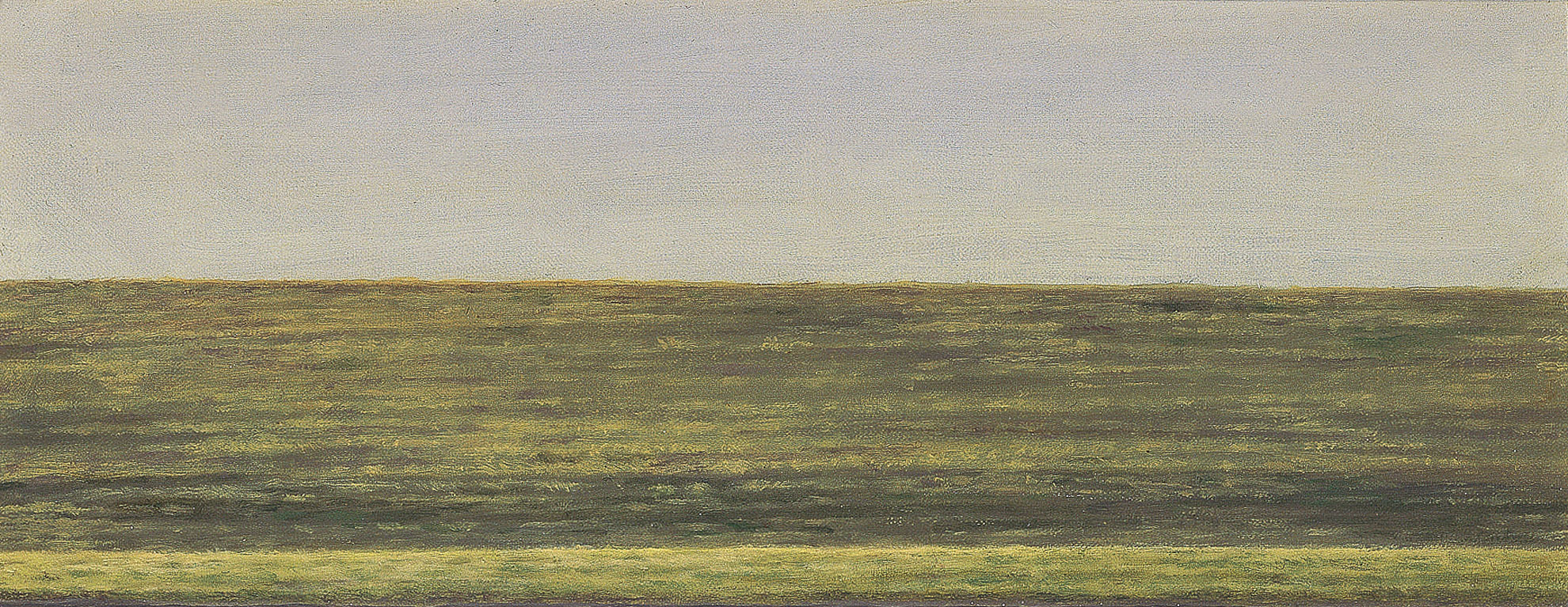Julie Bozzi: Landscapes 1975–2003

Julie Bozzi
Embankment-Air Base, 2000
Oil on linen
4 x 10 inches
Acquired in 2001
Collection of the Modern Art Museum of Fort Worth, Museum purchase, Sid W. Richardson Foundation Endowment Fund
Julie Bozzi's landscapes depict the spaces between the picturesque events others tend to seek out as they scan a panorama. What they lack in heroic impact, however, they make up for in their subconscious familiarity as American places. A resident of Texas since 1980, Bozzi often paints areas around Fort Worth and Dallas, along the Gulf Coast, and in the eastern Texas Piney Woods. Her approach involves sitting in her car near dusk in front of the chosen site and painting directly onto the canvas. The format of her works—narrow vistas—echoes the view through her car windshield.
"Always portraying the overlooked areas within a landscape - the parts without the usual dramatic or monumental elements—Julie Bozzi sees her choice of subject matter as a kind of rescue," says Modern Associate Curator, Andrea Karnes.
Born in 1943 in California, Bozzi attended graduate school at the University of California, Davis and participated in the arts program at Skowhegan School of Painting and Sculpture in Maine. She began painting en plein air in the summer of 1975. The exhibition Julie Bozzi; Landscapes 1975–2003, begins at this time and continues to her work in the present day. The exhibition is organized by the Modern Art Museum of Fort Worth and Associate Curator Andrea Karnes.
Without actually depicting people, Bozzi reveals the ordinary intersections between nature and culture. Karnes says, "from this unassuming body of work comes intensely considered images that invite contemplation and deeply reflect the artist's devotion to her subject." Bozzi's scenes show the backdrops that camouflage man-made structures, or small pockets of natural growth within urban spaces. Bozzi's intense treatment of a given location puts viewing it in an entirely new light. There is an undercurrent of anxiety that keeps her scenes from being benign. These works depict "outskirts" - the pockets of land where you find the empty six-pack, such as the scene in Bozzi's painting Texas, 1978. This is where people go who are themselves on the fringe.
The artist's formal compositions are as atypical as her subject matter. While the classic landscape scene invites the viewer in along diagonals receding into space, Bozzi's paintings are invariably frontal. Space is created almost entirely through overlapping. In many cases, a barrier such as a wall, hedgerow, fence or road, comprises a significant portion of the composition, denying easy access to the space beyond, for example Santa Monica Boulevard Near Bronson Avenue, Los Angeles, California, 1980. In this way, her landscapes reflect the acute objectivity of her own time. As she matured as an artist in the 1970s, Minimalism was in full force. Bozzi was clearly influenced by elements within the movement, applying some Minimalist characteristics to representational objects. Her non-hierarchical compositions, stripped down colors and the frontality of her pictorial field relate specifically to minimalist sculpture and can be seen in almost all of her works.
Bozzi's imagery is also an eccentric synthesis of post-war portrayals of the American landscape. With progress, westward expansion and a shift from agriculutral to industrial development at the turn of the century, landscape painting evolved from projecting the "promise land" to mirroring a changing nation. Rejecting the romantic grandeur of their predecessors, the early twentieth century Ashcan school created politically charged urban scenes with an imagery that acknowledged social problems. Artists involved with the Ashcan school, such as Arthur B. Davies, Robert Henri, and John Sloan, depicted, much to the distaste of their critics, scenes such as the alley ways and slumns of inner city dwellings. In the 1930s and 1940s, nationalism resurfaced with the Regionalists, who celebrated the American lifestyle by depicting rural scenes in a concise manner, among them, Grant Wood, John Steuart Curry and Thomas Hart Benton. Bozzi, by her use of urban sites that appear rural, might be seen as creating gentler versions of these two extremes. However, more so than with the Ashcan school or the Regionalists, Bozzi's work pays homage to the influential American painter, Edward Hopper, who was painting at the same time as Benton and the Regionalists, but on the opposite end of the landscape spectrum. Bozzi's work is more scaled-down and condensed, but both artists depict a straightforward, sober American landscape without epic markers or glorifications.
Hopper painted the American scene, but rather than nationalistic, his works were personal and charged with a psychological impact, often conveying loneliness and the vacuity of city life. In his notes on painting, Hopper wrote, "The question of the value of nationality in art is perhaps unsolvable. In general it can be said that a nation's art is greatest when it most reflects the character of its people." Bozzi's scenes indicate that she, like Hopper, acknowledges darkness within the American character.
Julie Bozzi
Embankment-Air Base, 2000
Oil on linen
4 x 10 inches
Acquired in 2001
Collection of the Modern Art Museum of Fort Worth, Museum purchase, Sid W. Richardson Foundation Endowment Fund
